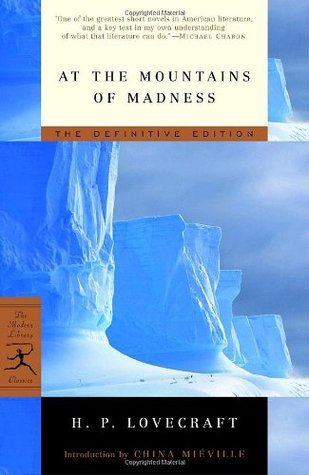What do you think?
Rate this book


194 pages, Paperback
First published January 1, 1931









Doubt of the real facts, as I must reveal them, is inevitable; yet if I suppressed what will seem extravagant and incredible there would be nothing left.
Six feet end to end, three and five-tenths feet central diameter, tapering to one foot at each end. Like a barrel with five bulging ridges in place of staves. Lateral breakages, as of thinnish stalks, are at equator in middle of these ridges. In furrows between ridges are curious growths–combs or wings that fold up and spread out like fans which gives almost a seven-foot wing spread. Arrangement reminds one of certain monsters of primal myth, especially fabled Elder Things in the Necronomicon.













“10:15 P.M. Important discovery. Orrendorf and Watkins, working underground at 9:45 with light, found monstrous barrel-shaped fossil of wholly unknown nature; probably vegetable unless overgrown specimen of unknown marine radiata. Tissue evidently preserved by mineral salts. Tough as leather, but astonishing flexibility retained in places. Marks of broken-off parts at ends and around sides. Six feet end to end, 3.5 feet central diameter, tapering to 1 foot at each end. Like a barrel with five bulging ridges in place of staves. Lateral breakages, as of thinnish stalks, are at equator in middle of these ridges. In furrows between ridges are curious growths. Combs or wings that fold up and spread out like fans. All greatly damaged but one, which gives almost seven-foot wing spread. Arrangement reminds one of certain monsters of primal myth, especially fabled Elder Things in Necronomicon. These wings seem to be membraneous, stretched on framework of glandular tubing. Apparent minute orifices in frame tubing at wing tips. Ends of body shrivelled, giving no clue to interior or to what has been broken off there. Must dissect when we get back to camp. Can’t decide whether vegetable or animal. Many features obviously of almost incredible primitiveness. . . . Having trouble with dogs. They can’t endure the new specimen, and would probably tear it to pieces if we didn’t keep it at a distance from them.”I’ll stop here, because I don’t want to spoil things for you. Things get weirder with Lake’s account of the dissection, and even weirder when—soon after—his regular transmissions disappear into radio silence. It is then that the narrator, geology professor William Dyer, accompanied by graduate student Danforth, go in search of the advance expedition. What they find are the ruins of an alien civilization, a tale of cultural degeneracy outlined in bas-relief, an explanation for the disappearance of Lake and his men, and a final intolerable horror.
“On the barren shore, and on the lofty ice barrier in the background, myriads of grotesque penguins squawked and flapped their fins”.Yep! We are in Lovecraft’s universe where even penguins are grotesque. I mean, whoever heard of an ugly penguin? At the Mountains of Madness is H.P. Lovecraft’s best known novel, not that difficult an accomplishment as he did not write that many (only this one and The Case of Charles Dexter Ward I believe. A wise decision because I find that his style is much more suited to the short story format. There are some amazing, creepy and wildly entertaining tales in the “greatest hits” anthology The Best of H.P. Lovecraft Bloodcurdling Tales of Horror and the Macabre that I


I could not help feeling that they were evil things—mountains of madness whose farther slopes looked out over some accursed ultimate abyss… appalling reminders of the utter remoteness, separateness, desolation, and aeon-long death of this untrodden and unfathomed austral world.



...the core science of [Lovecraft’s] materialist horror is biology, with that grotesque, meticulously reported anatomy lesson, that precise itemization of the impossible.